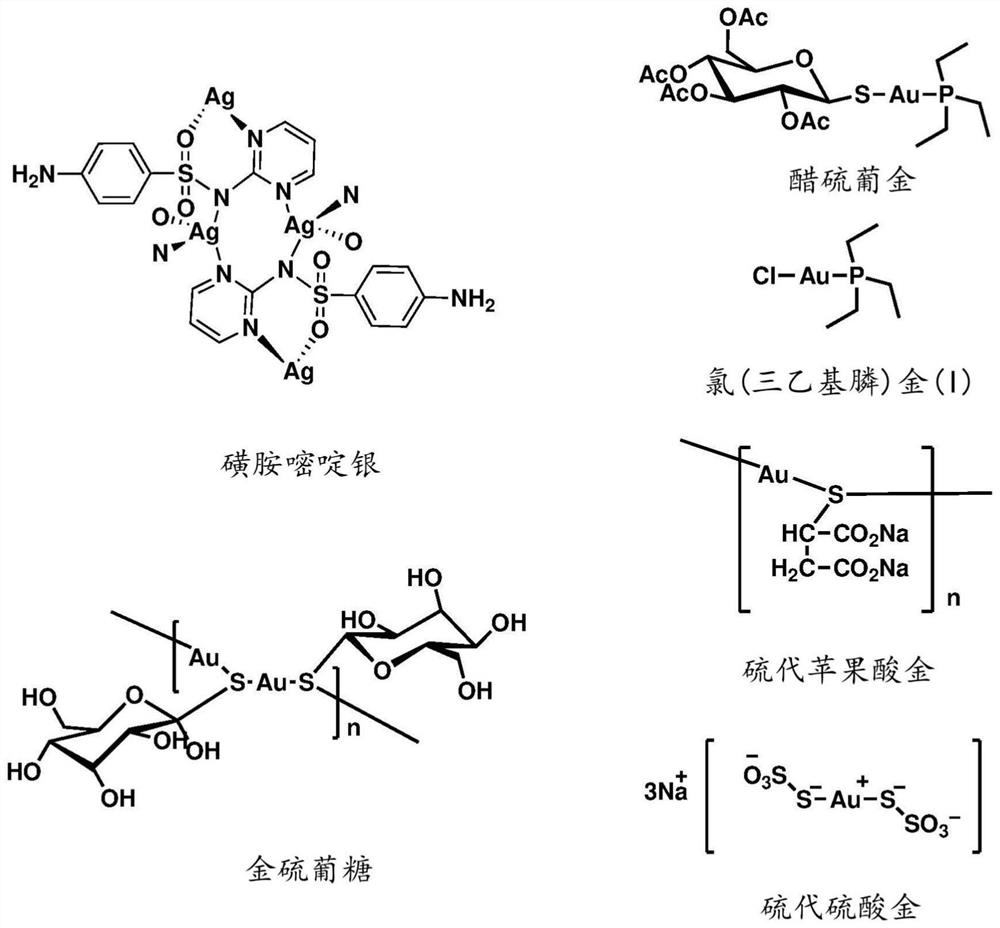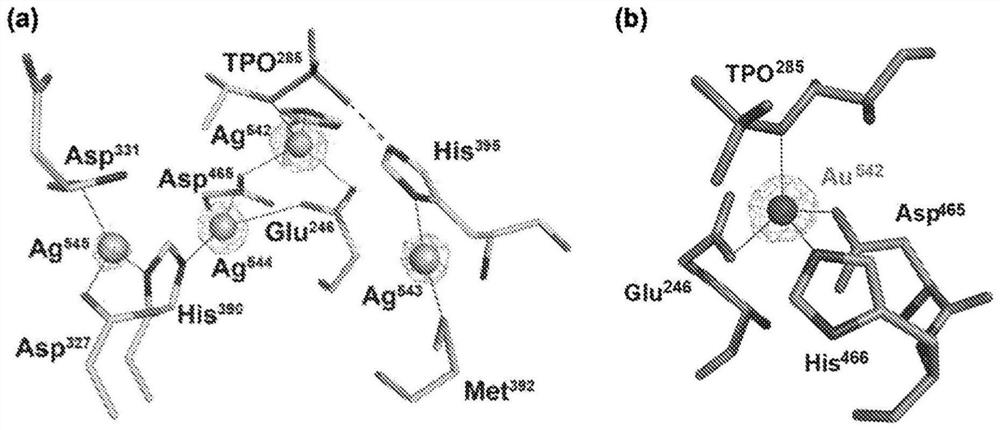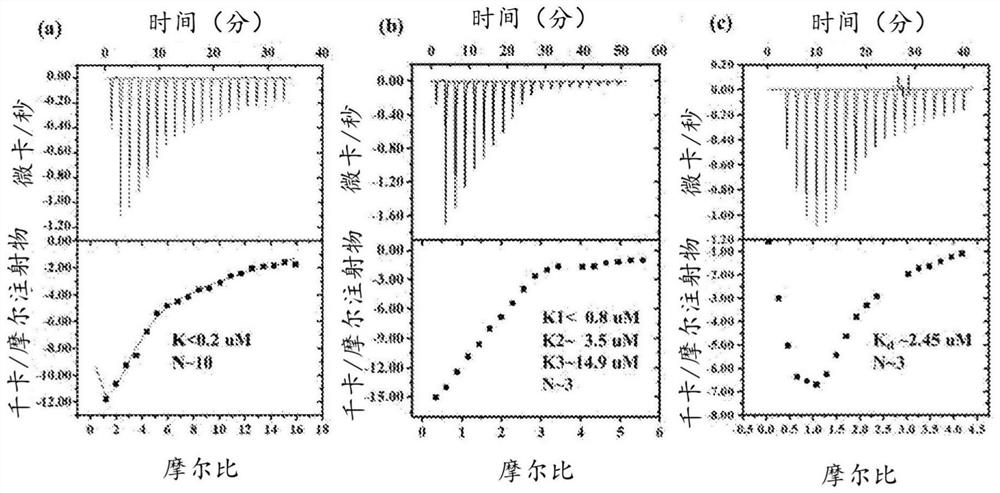Silver/gold compounds and methods thereof
A silver compound and compound technology, which is applied in the directions of heavy metal compound active ingredients, phosphorus compound active ingredients, pharmaceutical formulations, etc., can solve problems such as the limited speed of gene transmission
- Summary
- Abstract
- Description
- Claims
- Application Information
AI Technical Summary
Problems solved by technology
Method used
Image
Examples
Embodiment 1
[0072] Example 1: Crystallographic studies of silver / gold bound to MCR-1
[0073] Plasmid construction of wild-type mcr-1, mcr-1 variants, other mcr genes, and mutant and truncated mcr-1 forms
[0074] Primary plasmids encoding full-length MCR-1 and primary plasmids encoding soluble truncated parts (200-541 aa) were collected from Dr. Pak Leung Ho's group (Hong Kong University) and Prof. Hao Quan's group (Hong Kong University), respectively. These primary genes were subcloned into pCR-XL-TOPO and pET-15b vectors via SacI / BamHI restriction sites and NdeI / BamHI restriction sites, respectively. All subsequent modified plasmids were constructed from the primary plasmid as a template for PCR. Point mutations were introduced into the mcr-1 gene using the QuickChange (Stratagene) commercial kit, and verified by DNA sequencing (BGI, China). PCR was performed using KOD Hot Start DNA Polymerase (Novagen) according to the reaction conditions described in the manufacturer's protocol. A...
Embodiment 2
[0081] Example 2: In Vitro Mechanism Study of Enzyme Inhibition
[0082] ITC assay
[0083] Apo-MCR-1-S without any tag was diluted to a concentration suitable for the ITC assay. (1) 1mM Zn(Ac) 2 Added to 30μM apolipoprotein-MCR-1-S; (2) 1.1mM AgNO 3 Added to 7 μM Apo-MCR-1-S; (3) Added 1.1 mM AuCl to 30 μM Apo-MCR-1-S; (4) Added 1 mM other compounds to 30 μM Apo-MCR -1-S. Negative groups were performed in dialysis buffer with or without 1% DMSO, as appropriate. The stoichiometry and binding affinities of metal binding were obtained by fitting the data with appropriate equations, and these assays were performed in triplicate. Such as image 3 As shown in, MCR-1-S and AgNO 3 , AuCl and Zn(Ac) 2 The binding dissociation constant (K d ) were determined to be about 0.2 μM, 0.8 μM and 2.45 μM, respectively. Corresponding data such as image 3 shown.
[0084] PAR detection
[0085] By Varian (Varian) Cary 50 spectrophotometer, at a rate of 360nm / min, using 1cm -1 Quart...
Embodiment 3
[0094] Example 3: Evaluation of antimicrobial activity in vitro
[0095] The antimicrobial activity of silver / gold against MCR-producing bacterial strains was examined. Methods involve cell-based minimal inhibitory concentration assays, time-kill assays, and in vitro cell infection assays.
[0096] bacteria
[0097] The bacteria used involved Escherichia coli J53, Escherichia coli DH5a, Escherichia coli BL-21, Escherichia coli clinical isolate 1493, Salmonella enterica clinical isolate, Salmonella typhimurium, Klebsiella pneumoniae pneumoniae), Shigella flexneri, Enterobacter aerogenes, Enterobacter asburiae, Enterobacter kobei.
[0098] Micro dilution MIC detection
[0099] First, the MIC values of antibiotics or Bi(III) compounds were determined by standard broth microdilution method (Clinical and Laboratory Standards Institute (CLSI) M100-S20, 2010). Briefly, bacterial cells were cultured overnight in LB broth at 37°C at 250 rpm, using a microtiter plate reader at 600...
PUM
 Login to View More
Login to View More Abstract
Description
Claims
Application Information
 Login to View More
Login to View More - R&D
- Intellectual Property
- Life Sciences
- Materials
- Tech Scout
- Unparalleled Data Quality
- Higher Quality Content
- 60% Fewer Hallucinations
Browse by: Latest US Patents, China's latest patents, Technical Efficacy Thesaurus, Application Domain, Technology Topic, Popular Technical Reports.
© 2025 PatSnap. All rights reserved.Legal|Privacy policy|Modern Slavery Act Transparency Statement|Sitemap|About US| Contact US: help@patsnap.com



